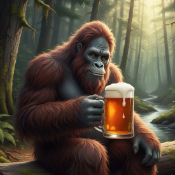Dr. Mayor expanded on this unique discovery.
"Finding what appears to be a very large structure, seemingly created with intention and requiring great strength as well as foresight, is interesting. It is not unheard of for primates to stack sticks or rocks, although for me, the jury is still out as to what that was. There is no guess work in science. It is great is that eDNA was collected from that site. That may give us the answers we are looking for."
I know @hiflier contacted Dr. Mayor months ago when he was researching his eDNA project...
Miroslava Munguia Ramos, project manager at the UCLA California Environmental DNA program, has analyzed the eDNA sample from the tree structure. Following are her observations.
"We received soil samples from your team and took a few months to get them processed. What we’re looking at are the unique organisms that we were able to identify. Our software does what’s known as metabar coding. So, it’ll match up all the DNA sequences that we were able to detect and try to cross reference them with the thousands of genomes that have been published and it’s pretty common that when we’re looking at environmental DNA samples, we detect humans, because there’s going be human traces almost everywhere."
"But what I found very interesting was that, yes, we have detected human DNA in these areas, but we’re still seeing different primate DNA. There wasn’t just one human primate, there are several different primates, some sort of primate relative that exists in the data."
"Pan troglodyte is a species of chimpanzee, which you would not see in the areas you’re at. It’s a real head scratcher. It’s important to note that the higher the detection, the more confidence we can say that whatever organism, whatever taxonomy we’re looking at was apparent in the area. And in this case, we’re looking at the Pan genus, or the chimpanzee genus…. there’s 3000 reads."
"The technology is constantly improving, it’s getting more accurate, and now it just really comes down to making sure we have enough samples and we’re confident that whatever we’re studying is a unique species."

